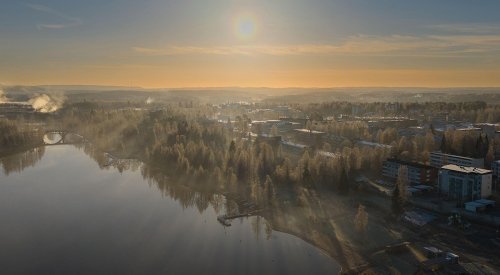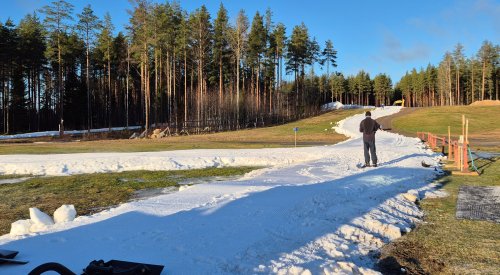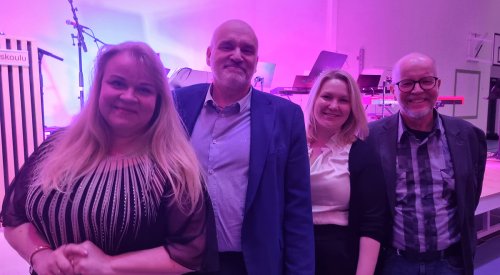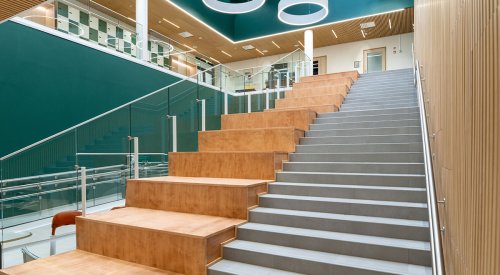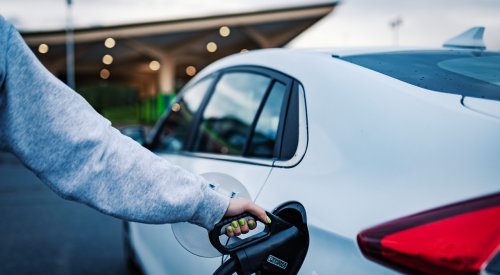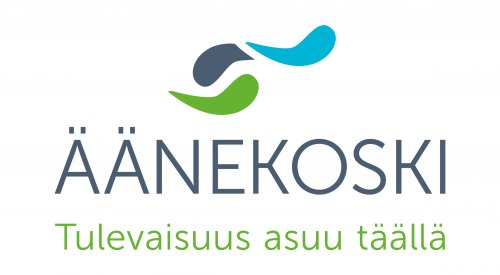”Energiansäästötavoitteissa olemme hyvin aikataulussa”
Äänekosken kaupunki on mukana kuntien energiasopimuksessa ja liittyi ensimmäisenä Keski-Suomessa Hinku-verkostoon
Äänekosken kaupunki tavoittelee hiilineutraaliutta vuoteen 2030 mennessä. Tavoite on saavutettavissa, mutta vaatii sitoutunutta työtä paitsi kaupungilta niin myös yrityksiltä ja asukkailta.

Äänekosken kaupunki on tehnyt hyvää ilmastotyötä vuosien ajan pitkäjänteisesti.
– Olemme edelläkävijöitä, eikä se ole meillä vain tulevan talven juttu. Äänekoskella energiansäästöasiat ovat vahvasti esillä ja mukana kaikessa toiminnassa, ympäristöpäällikkö Hanna Ahonen sanoo.
Äänekoski on liittynyt Kuntien energiantehokkuus -sopimukseen vuonna 2013 ja Hinku-verkostoon vuonna 2019. Molemmat verkostot perustuvat vapaaehtoisuuteen. Panostamalla ilmastotyöhön saadaan taloudellisia säästöjä, mutta samalla lisätään paikkakunnan hyvinvointia.
Äänekosken kaupunki on lisännyt muun muassa uusiutuvan energian käyttöä.
– Aurinkovoimaloita eli paneeleita pyritään rakentamaan joka vuosi ja ne sijoitetaan rakennusten katoille. Ilmalämpöpumppuja on asennettu sähkölämmityskohteisiin ja muutama iso hallikin on näillä toteutettu, suurin on jopa 2 000 neliötä. Koiviston, Hietaman ja Honkolan koulujen öljylämmitykset on korvattu pellettivoimalaitoksilla, energiainsinööri Juha Saari kertoo.
– Näitä samoja toimenpiteitä voivat kaupunkilaisetkin omissa kodeissaan toteuttaa.
Energiatehokkuus on ilmastoteko
Äänekoski on ollut mukana Kuntien energiatehokkuus -sopimuksessa (KETS) vuodesta 2013 saakka. Nykyinen eli jo toinen sopimus on solmittu Työ- ja elinkeinoministeriön kanssa vuonna 2017 vuoteen 2025 asti. Liittymällä sopimukseen Äänekoski on vapaaehtoisesti sitoutunut vähentämään ja tehostamaan kaikkea energiankulutustaan.
– Sopimuksen solmiminen merkitsee enne kaikkea vastuullisuutta energiankäytössä ja erityisesti kasvihuonekaasuista hiilidioksidin vähentämistä. Energiankäytön hiilidioksidipäästöjä seurataan jatkuvasti CO2 -vuosiraporttien avulla, Hanna Ahonen kertoo.
Liittyvä kunta asettaa liittyessään ohjeellisen energiamääräisen (MWh) tehostamistavoitteen kaudelle 2017–2025.
– Laskennallinen energiansäästötavoite vuodelle 2025 on 7,5 prosenttia vuoden 2016 tasosta ja välitavoite vuodelle 2020 oli neljä prosenttia, Saari sanoo.
– Äänekosken kaupungin sopimukseen on kirjattu toimenpiteitä, kuinka tavoitteisiin päästään. Sopimuksessa on toimenpidesuunnitelma ja energiansäästötavoitteet, niiden saavuttamisen seuranta ja tunnistetut riskit tavoitteiden saavuttamisessa. Energiatehokkuus huomioidaan myös esimerkiksi julkisissa hankinnoissa, kaavoituksessa, liikenteen suunnittelussa ja rakentamisessa.
Myös uusiutuvien energialähteiden käyttöönottoon kiinnitetään huomiota. Yhtenä tavoitteena on, että tänä vuonna 2021 fossiiliset polttoaineet korvattu energiatehokkaammilla muilla ratkaisuilla.
– Kaupungilla ei ole enää missään käytössä öljylämmitystä, kun viimeisestä Hietaman koulustakin se vaihdettiin toiseen lämmitysmuotoon viime vuonna, Saari kertoo.
– Sopimuksen puitteissa olemme hyvin aikataulussa, Saari toteaa tyytyväisenä.
Äänekosken kaupungin oma energiatehokkuustyöryhmä kokoontuu säännöllisesti ja seuraa toimintasuunnitelman toteutumista. Sopimukseen kuuluu myös toteutuneista toimista raportointia. Nyt kun tulevalla lämmityskaudella tehdään lisäsäästötoimenpiteitä, työryhmä kokoontuu useammin.
Koko maassa Energiatehokkuus -sopimukseen liittyneitä yrityksiä on 714, toimipaikkoja 7 136 ja kuntia ja kuntayhtymiä 123. Mukaan liittyneiden tahojen energiankäyttö kattaa lähes 60 prosenttia Suomen kokonaisenergiankäytöstä. Sopimukseen sitoutuneet tekevät vuosittain tuhansia energiatehokkuustoimia: vuosina 2017-2020 tehtyjen lähes 15 000 energiatehokkuutta parantavan toimenpiteen ansiosta vuosittain säästyy energiaa 8,9 TWh. Määrä vastaa yli 444 000 sähkölämmitteisen pientalon koko vuoden energiankulutusta.
Kova hinku vähentää päästöjä
Äänekosken kaupunki liittyi vuonna 2011 ensimmäisenä keskisuomalaisena kuntana Hiilineutraalit kunnat eli Hinku -verkostoon. Verkostoon kuuluvien tavoitteena on 80 prosentin päästövähennys vuoteen 2030 mennessä vuoden 2007 tasosta.
Hinku-kunnaksi liittymisellään Äänekoski on halunnut osoittaa, että teollisuuskaupunkikin voi kehittyä kestävästi. Samalla Äänekoski on toiminut suunnannäyttäjänä muille Keski-Suomen kunnille ja kaupungeille.
Verkostoon kuuluu tällä hetkellä yli 80 kuntaa ja viisi maakuntaa. Kunnianhimoisiin päästövähennyksiin sitoutuneiden kuntien ja maakuntien lisäksi verkostoon kuuluu ilmastoystävällisiä tuotteita ja palveluita tarjoavia yrityksiä ja energia- ja ilmastoalan asiantuntijoita. Mukaan pääsy edellyttää tiettyjen Hinku-kriteerien täyttymistä.
Pallo eteenpäin!
Äänekosken kaupunki haastaa naapurikunnat Kannonkosken, Konneveden, Laukaan, Saarijärven, Uuraisen, Vesannon ja Viitasaaren liittymään Hinku-verkostoon ja Kuntien energiatehokkuus -sopimukseen (KETS), jos joku kunnista ei ole niissä vielä mukana. Tarttuuko joku naapureista haasteeseen?
Äänekosken kaupunki osallistuu Keski-Suomen Liiton ilmastoviikon viestintäkampanjaan julkaisemalla tiedotesarjan 10.-14.10.2022 Äänekosken kaupungin ilmastoteoista. Äänekosken kaupunki haluaa haastaa myös henkilöstönsä, asukkaat, yritykset ja muut tahot yhteisiin ilmastotalkoisiin. Kestävä ympäristö on myös yksi tärkeimmistä tavoitteista Äänekosken kaupunkistrategiassa.
Lisätietoja:
Ympäristöpäällikkö Hanna Ahonen, 0400 893 683, hanna.ahonen@aanekoski.fi
Energiainsinööri Juha Saari, 040 572 9182, juha.saari@aanekoski.fi
Uutinen julkaistu 10.10.2022

















